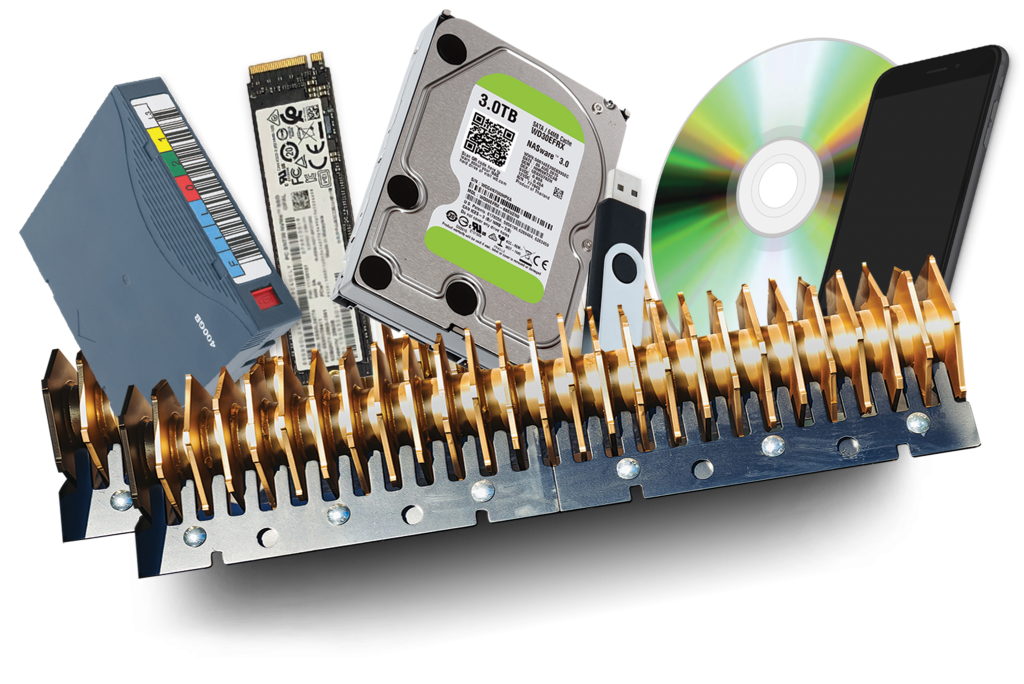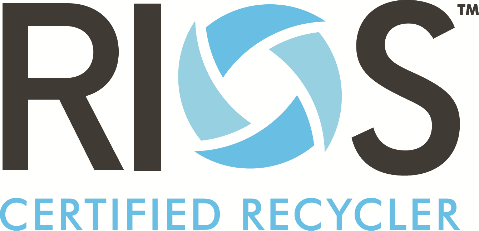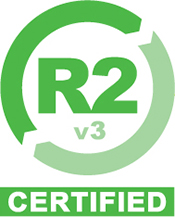
Electronics Recycling
Electronics Recycling in Philadelphia, Delaware, and New Jersey. When your electronics have reached the end of their useful life, or you’ve upgraded to the latest technology, your electronic devices need to be recycled (and whatever data remains on them destroyed). We handle the entire process from pick up to final disposal. We make sure NONE of your old technology ends up in a landfill in the United States, or somewhere overseas (or worse, in the ocean).
Our Computer and Electronics Recycling Process is state of the art, certified, and secure. We meet the highest standards of the U.S. Government, are R2 Certified (we hold multiple certifications) and a member of NAID.

What Devices Require Electronics Recycling?
The following are all considered e waste and require electronics recycling:
- Audio and Stereo Equipment
- Cellular Phones
- Computers and Computer Peripherals
- Telephones, Fax and Copying Machines
- Televisions and Monitors
- VCRs and DVD Players
- Video Cameras
- Video Game Consoles
- Wireless Devices
- Desktop Printers
- Copy Machines
- Portable Hard Drives
- Thumb Drives
- DVD’s and CD’s
- Digital Cameras
- And more!
Protecting Your Data – Data Destruction During Electronics Recycling
You would be surprised where you can find data and how hard it can be to destroy. Desktop printers can store data. Micro-memory cards can hold many Gigabytes of data on them. Phones, thumb drives, old tablets, and laptops can hold a huge amount of data, and that data can be recovered and used for nefarious purposes.
Just “erasing” or “deleting” files from your laptops, computers, thumb drives, and other media is generally insufficient to make sure your personal data, passwords, banking info (and access) can never be recovered again. All it takes is some software and a little creativity, and someone can restore nearly everything you thought you had permanently erased.
Computer hardware components like hard drives and servers are also not easy to destroy. Dropping it off the top of a building, smashing it with a hammer, or running over it with your car are all methods we are aware of that people have tried to use to disable hard drives, and none of them work. You can’t just smash components and media with a hammer and be sure your data is protected.
Media destruction is the same. Internal components of some mini drives must be ground down to pieces smaller than two millimeters to be certain none of the data on them can be recovered. Smashing that thumb drive with a hammer isn’t going to make it secure.
When you use Life Cycle Solutions, you can know that we know exactly where to check for hidden data and how to destroy it so it can never be recovered. Once we are certain there is nothing left to find on your old computers and electronics, we send it back to our lab to test it again anyway. We take data destruction and computer recycling seriously, and you should too.
Environmental Considerations – Where Did Your Computers and Electronics End Up?
Electronics recycling separates all of the individual components into tiny little pieces and many of those pieces are terrible for the environment. When we perform electronics recycling, none of those components end up in a landfill – or in an overseas landfill – or at an overseas “chop shop” – or worse, in the ocean.
Unfortunately– all of these things can happen (and do happen every day). But if you work with us, you can rest easy knowing that we verify ALL of our downstream vendors. We know precisely where your materials end up. We verify it because we care a great deal about the environment, and we know our customers do too.
Commercial Electronics Recycling – Secure Transport – Secure Chain of Custody – Secure Data Destruction – Environmentally Friendly Disposal
Our crews will collect, label, and seal all storage media in locked boxes and transport them to our secured facility. Chain of Custody is tightly controlled. To learn more about our process – visit Our Processes Page
Once inside our secure facility, every step of the process is documented and verified. Every piece of equipment is tested and verified for proper data destruction and then tested again. Data destruction certificates and reports are available upon request. And lastly – your electronics are disposed of properly to protect the environment from the hazardous materials left over from electronics recycling.
Commercial Electronics Recycling – Secure Transport – Secure Chain of Custody – Secure Data Destruction – Environmentally Friendly Disposal
E waste is a problem that most people and businesses did not anticipate. There is an ever-increasing appetite for new electronics, faster electronics, and better electronics. The pace at which computers, smart phones, digital devices like cameras (remember digital cameras?), and portable storage become obsolete, is unbelievable.
And all of these electronics, computers, laptops, iPhone, digital cameras, monitors, screens, televisions, tablets, printers, etc, all have to go somewhere when they have reached the end of their useful life, which in today’s marketplace can easily happen in less than twelve months.
Along with this craving for computers and electronics and technology advancement has come bigger, better, and tinier data storage vehicles. It wasn’t that long ago that having 250 megs of storage on a thumb drive was incredible. Now – those same thumb drives can store Gigabytes of sensitive information. Mini-SSD chips must be ground up to pieces smaller than 2mm to guarantee data cannot be recovered. Printers can store data. CD’s often get left in CD/DVD drives when big offices switch computers and have to throw away the old ones.
By 2016, almost every person in the United States owned a phone – and – every second person also owned a tablet computer. Close to 25% also owned an e-book reader. Between 2012 and 2015, the number of Americans who owned a smartphone, AND a computer, AND a tablet doubled to 36% of adults.
Have you ever stopped to think about where all of these devices end up? Prior to reputable electronics recycling practices, computers (with hard drives intact) could be shipped overseas to “chop shops” and sensitive data could be easily compromised. And the left-over parts? Those were often thrown in mass landfills overseas or were sometimes thrown directly into the ocean where heavy metals like mercury and chemicals will pollute the water and the food supply.
And then there is the environmental impact. All of these electronics contain within them metals and chemicals that are terrible for the environment and if dumped in a landfill, can eventually find their way into the water supply.
Because of the sheer demand for data destruction and environmentally responsible computer and electronics recycling, new laws have been passed to protect the environment, and standards and procedures were developed for proper electronics recycling. There are now several associations for electronics recyclers in the United States, and more and more companies are entering the electronics recycling industry.
This is also why Life Cycle Solutions is R2 Certified, and a member of NAID – because we believe in what these associations are doing, and we know there must be standards developed, maintained, and verified for computer and electronics recycling. Otherwise, people just tend to “do whatever.” This way of thinking is unacceptable for your companies data security, and unacceptable for the environment.
Are you wondering what to do with your old electronics? America’s growing use of electronics has created a new environmental challenge: electronic waste, or e-waste.
Is E Waste That Big Of a Deal? – Yes, it is.
- By 2016, the world generated 44.7 million metric tons (Mt) of e-waste, which is roughly equivalent to 4,500 Eifel Towers, and only about 20% was recycled through appropriate channels according to the global E-waste monitor report from the United Nations.
- Electronic equipment contains toxic materials like lead, mercury, cadmium, and many of these toxic materials will end up in the water supply (if dumped) or in the air (if burned)
- Old electronics (E waste are the fastest growing source of waste in the U.S. By 2016 over three billion electronic devices will need recycling, which is an average of close to 400 million units per year according to the Electronics TakeBack Coalition.
- It is a HUGE waste of resources. The total value of all raw materials present in e-waste is estimated to be approximately 55 Billion Euros (in 2016), which is more than the 2016 Gross Domestic Product of most countries in the world.
How Can I Avoid Contributing to the E-waste Problem?
Choose a Responsible Recycler – Look for the R2 Certification On Their Website.
The Environmental Protection Agency offers two accredited certification standards for electronics recycling: R2 – the Responsible Recycling Practices (R2) and the e-Stewards® standards. If a company has the R2 Certification, they will proudly display it on their website (like we do).
The e-Steward Certification program is an amazing program that helps guarantee e-waste isn’t disposed of in landfills in developing nations. As we’ve mentioned before, for some time, the “cheap” way to dispose of e-waste was to ship it to countries who couldn’t afford oversight (and wherever government corruption flourishes) and dump toxic e-waste in landfills where people are too poor to do anything about it. The e-Steward certification forbids the dumping of toxic e-waste in developing countries, local landfills and incinerators; the use of prison labor; and the unauthorized release of private data. If you want to make sure your recycled electronics don’t end up in another country’s landfills and water supply – look for the e-Steward Certification.
How Can I Be a Responsible Consumer and Help Reduce E-waste?
Buy Green Electronics from Reputable Manufacturers.
Want to know if the product you are about to buy meets the best modern standards at the manufacturer level? You can check to see if that new device you are about to purchase meets the EPEAT standards and also see its rating. Here is a link to their tool where you can check: Electronic Product Environmental Assessment Tool You can use it to evaluate laptops, cell phones, desktop computers, tablets, and monitors to see if their manufacturers are helping or hurting the environment.
Manufacturer Takeback Programs and the Electronics Takeback Coalition
Some manufacturers are offering Takeback programs for your old electronics. They will take back and recycle their electronic products for you. Takeback help incentivize manufacturers to design products with their final destination in mind. They increase the use of recycled materials and decrease the use of toxic materials they would have had to deal with later. You can get access to a list of manufacturers who have take back programs from the Electronics TakeBack Coalition Just click on “Corporate Responsibility.”





